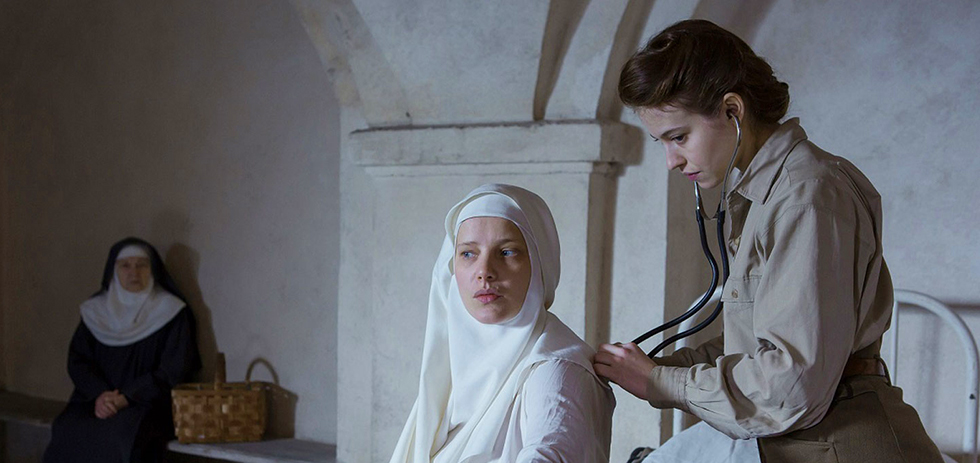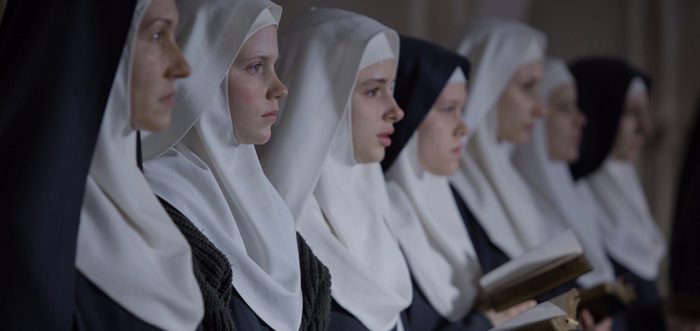
Rehistoricising the role of non cis-men is the arduous task facing many contemporary feminist filmmakers. War films are a necessary part of this process: distinctly feminine lenses hone in on personal stories, often sourced from real events. As the Iranian director Hana Makhmalbaf, whose Buddha Collapsed Out of Shame takes place in war-ravaged Afghanistan, put it: “Girls live war in our bodies.”
Told through personal stories of the mass-rape of Continental-European women during wartime, The Innocents, Anne Fontaine’s timely new postfeminist cultural critique, is entrenched in present-day debates around the trauma and shame resulting from the rape experiences of sexual assault survivors. Fontaine follows the Winter Offensive of 1945 through a group of pregnant nuns recovering in a cloistered convent, balancing burdensome silence with dialogue surrounding victim-blaming and anguish1. In her previous films, like Entre Ses Mains and Adore, Fontaine has displayed her fascination with the form of the thriller. This, coupled with her philosophical foundations and resolutely gender-critical eye, assist her in reclaiming a genre dominated by men, rehistoricising a period practically absent from accounts of Polish history until the dissolution of the Soviet Union.
The Innocents is a pan-European production written by Cahiers du Cinema alumni including Philippe Maynia, who drew inspiration from his aunt Madeleine Pauliac, a French Red Cross doctor positioned in Poland during World War II. Young doctor Mathilde (dreamily played by Breathe’s Lou de Laâge) is secretly taken to a Warsaw convent to deliver the baby of a novice nun. Mathilde learns that the convent, like much of the rest of Poland, was raided and raped by Soviet soldiers charged with liberating the country, leaving many women pregnant and others riddled with syphilis.
The claustrophobic, silent convent — expertly rendered by Fontaine, who inhabited several Benedictine convents for research — acts to remind us of the ongoing use of systematic rape as a weapon to oppress women. The Soviet soldiers — who are almost always credited with the liberation of Poland and other countries in Central Europe, as is the case with victor-written history — are daringly portrayed as exploitative predators. As Fontaine explains in the film’s production notes, the moral murkiness of the abuse perpetrated by these “saviours” often began with their superiors, who excused the soldier’s violation as necessary spoils of war.

Mathilde’s medical supervisor and lover, Samuel (Vincent Macaigne), is explicitly cast as an incarnation of contemporary notions of toxic masculinity, spending his time either playing Mathilde’s emotions or condescending to her when he’s not tearfully begging her for sex. The realities of systematic misogyny are more eloquently rendered, however, through the overwhelming agony, shame and terror of the pregnant nuns. Agata Kulesza (of Ida) and Agata Buzek (a new contender for the Tilda Swinton prize for imposing Venutian vulnerability in a supporting role) play off each other superbly as the stoic Mother Abbess and nun-second-in-charge of the abbey’s many gruesome secrets. One feels the skin crawl as a desperately weeping nun recoils from Mathilde’s touch, clawing at her grossly swollen stomach in a seemingly unending take, or when the Mother Abbess treks through the moat-like forest in terror, carrying a squalling baby in a bassinet.
Silence penetrates the film and nobody speaks the name of the malice haunting their lives, yet its presence is unavoidable; almost every exterior scene is bookended by an eye-watering birth. There’s an Artaudesque combination of cruelty and truth found in Fontaine’s films, developed in The Innocents through these gruelling, thigh-clenching deliveries. Religion becomes an abjection for the nuns as the births and deaths increase, and the film examines the limits to which one’s faith can be tested in the face of such bleakness — the nun’s believe that the violations of their chastities have consigned them to damnation. Fontaine uses this nuanced approach to the broader issues of shame and silence surrounding rape to realise a gradual feminine activism to the cloistered collective. Their banal daily activities combining conversations around faith are all dutifully recorded, reminding one of the gentle yet powerful studies of quotidian aesthetics pioneered by feminist filmmakers like Chantal Akerman. By adapting these techniques for the war film and inverting the genre’s concentration on masculine physical feats of combat to the distinctly feminine physical feat of birth, Fontaine joins the ranks of a growing number of filmmakers — including Makhmalbaf, Jasmila Žbanić and Juanita Wilson — examining bloodshed with sincere and dynamic feminist poetics.
There are a few clumsy elements that stymie The Innocents’ near-perfect push for visceral realism: the end is out of pace with the rest of the film, indulging in some truly naff narrative tropes; the supporting cast of nuns all seem selfsame beyond the four main characters and there are some poorly handled narrow escapes that are somehow more cringe-inducing than the harrowing birth scenes. By indulging mainstream audiences the film threatens to over complicate itself in a manner similar to Fontaine’s 2013 flop Adore, as it struggles to entertain and resolve a history strong enough to stand without the conventional cinematic trimmings.
Cinematographer Caroline Champetier, a long-time Godard and Rivette collaborator, and editor Annette Dutertre, turn the interior scenes out in stark black-and-white finish, tracking the nun’s frantic movements through the washed-out background colour of the wintry Polish vista. These intimate scenes inscribe The Innocents with a finality in addressing the destructive power of rape as a weapon of war, with its attendant violence and deep-rooted stigma. These shots form a gentle mosaic that challenges the divisions of not only documentary and fiction, or between frontiers, but also those that separate us from history, as the cloaked figures are shrouded by the stark architecture and sparse landscape of Central Europe — testament to history’s neglect of feminine trauma.
